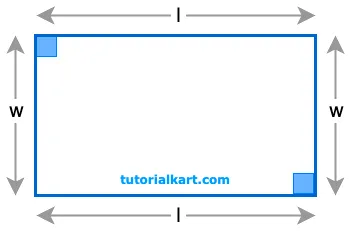Perimeter of a Rectangle Formula
The perimeter of a rectangle is the total distance around the shape, calculated by summing the lengths of all four sides. A rectangle has two pairs of opposite sides that are equal.

This makes calculating the perimeter straightforward when the length and width are known.
Here, we’ll go through the formula and examples for calculating the perimeter of a rectangle.
Formula for the Perimeter of a Rectangle
Using Length and Width:
If the length \( l \) and width \( w \) of the rectangle are known,

The perimeter \( P \) can be calculated with the formula:
\( P = 2(l + w) \)
In this formula:
- \( l \) is the length of the rectangle
- \( w \) is the width of the rectangle
Detailed Explanation of the Formula
Understanding the Formula
The formula \( P = 2(l + w) \) calculates the perimeter by adding the length and width and then multiplying by 2, as each side length appears twice in the perimeter calculation.
This approach is effective when both the length and width are known.
Example 1: Calculating Perimeter with Given Length and Width
Problem: Find the perimeter of a rectangle with a length of \( l = 12 \, \text{cm} \) and a width of \( w = 5 \, \text{cm} \).
Solution:
- Write down the formula: \( P = 2(l + w) \).
- Substitute \( l = 12 \) and \( w = 5 \): \( P = 2(12 + 5) \).
- Add the length and width: \( P = 2 \times 17 \).
- Multiply by 2: \( P = 34 \, \text{cm} \).
The perimeter of the rectangle is \( 34 \, \text{cm} \).
Example 2: Finding Width from Perimeter and Length
Problem: A rectangle has a length of \( l = 10 \, \text{cm} \) and a perimeter of \( P = 40 \, \text{cm} \). Find the width.
Solution:
- Start with the perimeter formula: \( P = 2(l + w) \).
- Substitute \( P = 40 \) and \( l = 10 \): \( 40 = 2(10 + w) \).
- Divide both sides by 2: \( 20 = 10 + w \).
- Subtract 10 from both sides to solve for \( w \): \( w = 10 \, \text{cm} \).
The width of the rectangle is \( 10 \, \text{cm} \).
These examples demonstrate how to calculate the perimeter of a rectangle or find an unknown side length based on the perimeter formula \( P = 2(l + w) \).
